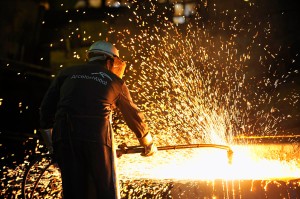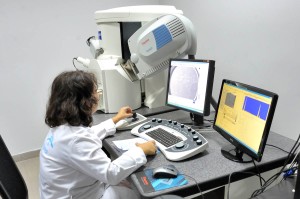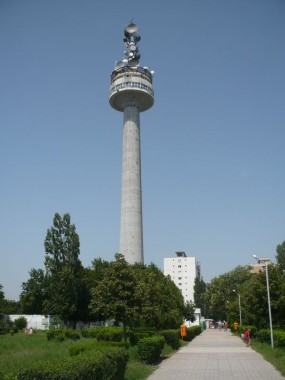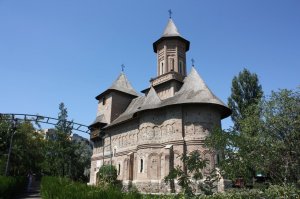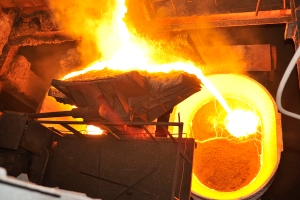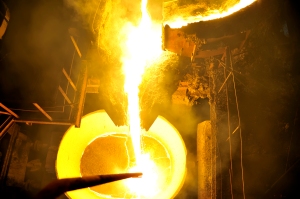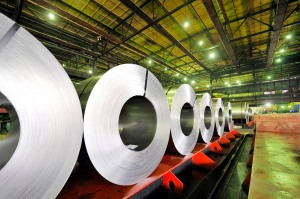The company
Galati is located in the historical region of Moldavia (Eastern Romania), on the left bank of the Danube, at 80 miles from the Black Sea. The town is the seventh most populous city in Romania with around 300,000 people living within the city.
ArcelorMittal Galati is the largest integrated iron and steel works in Romania, accounting for over 50 per cent of the country’s steel production. In the Flat Carbon Europe (FCE) organization, the site of Galati has been elected as the pivotal activity for its operations in the Black Sea and Balkans area, inside the East Business Division, which also includes Skopje (Republic of Macedonia), Ambalaj Turkey and Borçelik joint venture (Turkey). Although its location is ideal, between the emergent East and the expanding Turkish markets, Galati faces heavy competition in an increasingly demanding world.
Built on 1, 600 hectares, the Galati plant started its production in 1966. After a first privatization in 1991, it joined the ArcelorMittal Group (LNM Holdings at that time) in 2001. Its operational installations are composed of: one sinter plant, 5 blast furnaces (1 in operation, 1 idled), 1 steel melting shop, 3-strand curved mould slab casters, 2 heavy plate mills, 1 hot strip mill, 1 cold rolling mill and 1 galvanizing line.
The Unit produces high-quality plates, hot and cold rolled sheets and galvanized sheets. Two-third of its production is exported to more than 40 countries.
With a major modernization program underway, the company has set itself the goal of becoming the operating benchmark for steelmaking in Central and Eastern Europe. ArcelorMittal Galati has long produced the high quality steel required by the world’s demanding industries – including shipbuilding, the automotive sector, construction and earth moving, oil and gas. The company has achieved certification standards as diverse as the industries it serves.
The people
Romanians are among the friendliest and most hospitable people on earth, they resemble Italians in their desire for spiritual closeness, confidences and exploration of human feelings. The development of such relationships will make subsequent business dealings much easier to carry out. The Romanian culture is very rich in traditions and folklore. The culture steams from the inhabitants of Dacia, who occupied the ancient area; among other influences such as the Roman. Festivals feature brightly ornamented costumes with traditional dancing. Wood carvings, skillfully woven carpets, and pottery are some of the elements of traditional Romanian culture. Special folk arts of Romania are the decorated Easter eggs and painted glass. These items can be found in many markets and vendors near tourist attractions throughout the country.
You will be surprised at the ability of many Romanians to speak other languages, especially English and sometimes French and German. Education is compulsory between the ages of six and sixteen and the quality of the Romanian education is well-known.
Expats moving to Romania will find it both challenging and rewarding. For many people, Romania may conjure thoughts of fortune-telling Gypsies, Dracula and Transylvania; however, Romania has far more to offer, and is eager to make its mark both as an international tourist destination, and a gateway to business in Eastern Europe.
Romania is a very traditional country, but its people are eager to engage with the fast-globalizing world and all it has to offer. Tourism has become of special significance to Romania. Tourist attractions range from winter sports in the mountains to summer seaside activities in the resort belt fringing the Black Sea and also the Danube Delta.
Expats moving to Romania could spend their weekends at very different areas in Romania, such as:

Black Sea
Warm climate, miles of sand beaches, ancient monuments, vineyards and modern resorts invite expats to seriously consider Romania’s Black Sea Coast for spending their weekends.
 The Carpathian Mountains
The Carpathian Mountains
Romania’s diverse natural landscapes offer numerous choices for exciting outdoor experiences. The travelers can walk through serene alpine meadows covered with scores of wildflowers, trek around glacial lakes, take in the lush-green scenery while horse riding or mountain biking, climb curious rock formations, photograph fossil traces of 15,000-year old cave-bear species, track gold eagles or other rare birds, study endangered flora, wander in the countryside, picnic in the fields, try your hand at traditional crafts, – or just relax in the home of a village family and sample wholesome, country fare with home made wine and plum brandy.
Romania’s collection of castles and fortresses perhaps best illustrates the rich medieval heritage of the country. While castles built from the 14th to the 18th centuries are strong and austere fortresses built mainly for defense against invaders, those erected beginning in the late 1800s are imposing and luxurious.
The mighty Danube River flows 1,788 miles from its springs in Germany’s Black Forest to the Black Sea. Just before reaching the sea it forms the second largest and best preserved of Europe’s deltas: 2,200 square miles of rivers, canals, marshes, tree-fringed lakes and reed islands. The Danube Delta is a wildlife enthusiast’s (especially a bird watcher’s) paradise.
 The Painted Monasteries
The Painted Monasteries
Among the most picturesque treasures of Romania are the Painted Monasteries of Bucovina (in North-Eastern Romania). Their painted exterior walls are decorated with elaborate 15th and 16th century frescoes featuring portraits of saints and prophets, scenes from the life of Jesus, images of angels and demons, and heaven and hell.
The Galati tourism attractions are Danube Faleza, Fortified Church of Precista, Mavramol Church, The Orthodox Cathedral, Palace of Justice, Maritime Terminal, Botanical Garden, Museum of Visual Arts, Museum of History, Museum of Natural History, The Garboavele Forest — natural park(1,000 acres), the Ostrovul Prut Natural Park, Zoo, etc.

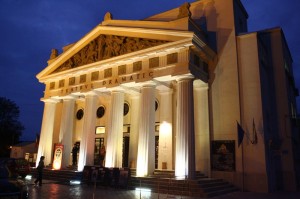
Musical Theatre “Nae Leonard” in Galati is the only institution in Romania which covers all genres of musical shows, from opera, operetta and symphonic concert to revue, musical comedy and shows for children.
Gulliver Theatre in Galati is the organiser of the most important animation festival in the country, which gathers each year the most significant artistic productions made in the country, but also prestigious guests from abroad: France, Italy, Bulgaria, Ukraine and Moldova.
The Dramatic Theatre “Fani Tardini” in Galati was the first theatre in Romania to organize a Comedy Festival in 1976, which represented the starting point in the competition which shortly after transformed Galati into the CAPITAL OF COMEDY. This is one of the most important cultural manifestations, which brings together the most renowned critics, playwrights, directors, theatre managers and actors who enjoy the pleasure offered by the reign of comedy shows from all around the country.
Working for ArcelorMittal Galati. Why not?

